The Range Cookers Market is estimated to be valued at USD 2.3 billion in 2025 and is projected to reach USD 3.4 billion by 2035, registering a compound annual growth rate (CAGR) of 4.1% over the forecast period.
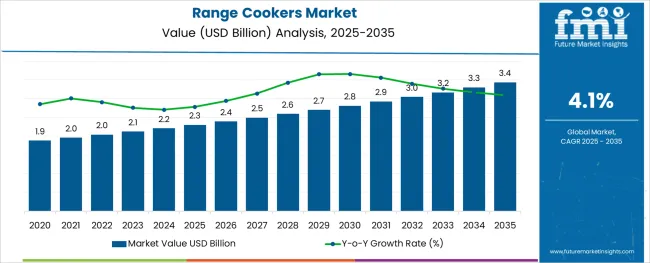
The range cookers market is demonstrating steady growth, supported by rising consumer preference for multifunctional kitchen appliances that combine traditional cooking methods with modern technology. Demand is being driven by a shift toward premium kitchen solutions, where aesthetics, durability, and energy efficiency converge to influence purchasing decisions.
Increasing urbanization, growing disposable incomes, and a heightened focus on home-cooking experiences have also accelerated adoption. Manufacturers are introducing innovative designs, energy-efficient features, and smart connectivity options, paving the way for enhanced user convenience and long-term savings.
Future opportunities are expected to emerge from technological advancements in fuel efficiency, customization in burner configurations, and increasing adoption in emerging economies where modern kitchen upgrades are gaining traction.
The market is segmented by Product Type, Application, Burner Type, and Sales Channel and region. By Product Type, the market is divided into Dual Fuel Range Cooker and Electric Range Cooker. In terms of Application, the market is classified into Residential and Commercial. Based on Burner Type, the market is segmented into Four Burner, Single Burner, Double Burner, Three Burner, and More than 4. By Sales Channel, the market is divided into Hypermarket/Supermarkets, Wholesalers/Distributors, Specialty Stores, Online Retailers, and Other Sales Channel. Regionally, the market is classified into North America, Latin America, Western Europe, Eastern Europe, Balkan & Baltic Countries, Russia & Belarus, Central Asia, East Asia, South Asia & Pacific, and the Middle East & Africa.
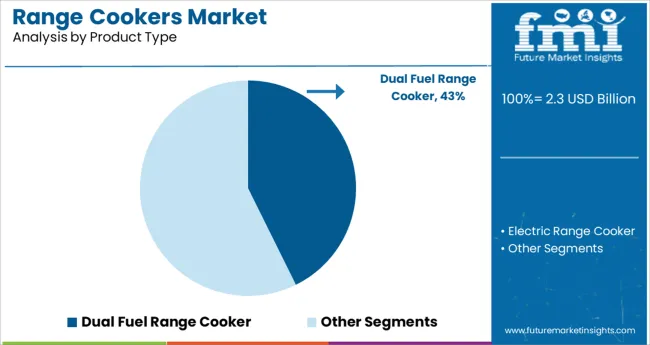
When segmented by product type, the dual fuel range cooker segment is projected to hold 42.7% of the market revenue in 2025, establishing itself as the leading product type. This leadership has been attributed to the combination of gas and electric capabilities, which provides users with enhanced precision, versatility, and reliability in cooking.
The dual fuel configuration has enabled superior control over heat distribution and baking performance, which has resonated strongly with both amateur and professional cooks.
Manufacturers have capitalized on this by offering premium finishes, larger capacities, and additional features that appeal to the evolving preferences of consumers seeking efficiency without compromising on cooking quality. The ability of this segment to meet diverse culinary needs has further reinforced its dominance in the market.
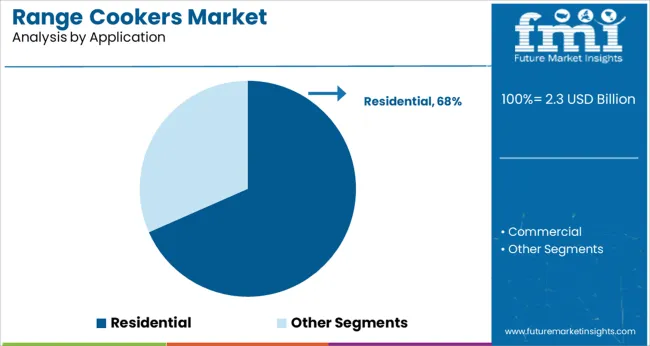
In terms of application, the residential segment is anticipated to account for 68.4% of the market revenue in 2025, maintaining its position as the top application segment. This prominence has been supported by the increasing focus on home improvement, lifestyle-oriented kitchen designs, and a surge in culinary enthusiasm among households.
he residential sector has embraced range cookers as a statement appliance that complements both functionality and aesthetics, which has been central to its widespread adoption. Consumer interest in hosting and preparing meals at home has created demand for appliances that offer professional-grade performance within a domestic setting.
Moreover, compact designs and energy-efficient models have made these cookers accessible to a wider base of households, cementing the residential segment’s leadership in driving overall market demand.
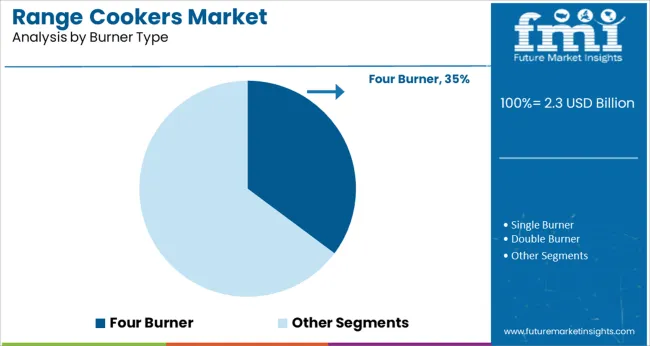
When segmented by burner type, the four burner configuration is expected to command 35.2% of the market revenue in 2025, emerging as the leading burner type. This segment has gained traction due to its optimal balance between space utilization and cooking capacity, making it particularly suitable for both small and medium-sized kitchens.
The four burner setup has been recognized for providing flexibility to prepare multiple dishes simultaneously without overwhelming countertop space. Manufacturers have focused on refining burner efficiency, safety mechanisms, and easy-to-clean surfaces within this segment, which has further elevated its appeal.
The practical usability and adaptability of four burner models to varied household needs have ensured their continued preference among consumers, reinforcing their dominant share in the market.
According to Future Market Insights, the global demand for range cookers is forecast to surge at a steady 4.1% CAGR between 2025 and 2035, in comparison with the 3.8% CAGR registered during the historical period from 2020 to 2024.
Range cookers are unitary kitchen appliances that combine an oven and a cooktop. These cookers are available in numerous sizes and types for both commercial and residential use. They help end users to cook easily and generally take up very less space as compared to conventional cooking appliances.
Many newer models of range cookers include built-in storage for pots and pans. Modern range cookers come in an array of monochromatic and pastel colors, making them ideal for modern kitchens.
Easy availability of a wide variety of kitchen appliances like range cookers at affordable prices is playing a key role in boosting sales globally. With the economic boom and increasing disposable income, the buying power of many consumers is rising substantially.
Today, consumers are spending large amounts on purchasing advanced kitchen equipment for their modular kitchens. This will continue to boost the global range cookers industry during the forecast period.
As technology advances, individuals are more interested in cooking appliances that can be turned to multi-task, easing their busy lives. Millennials are increasingly interested in range cookers, as they can prepare their hearty dishes over a range of temperatures using just a single appliance.
Range cookers are primarily being used in commercial settings, such as food delivery stations and restaurants that serve multiple cuisines. Hence, a growing number of these commercial settings due to increasing demand for ready-to-eat food products and rising consumer spending is likely to fuel sales of range cookers over the next ten years.
Growing Consumer Demand for Technologically Advanced and Sophisticated Kitchen Appliances boosting Market
In recent years, there has been a sharp rise in the sales of electric range cookers and dual fuel range cookers due to rising consumer inclination towards technologically advanced kitchen appliances, and the trend is expected to continue during the forecast period.
With developments like rapid economic boom, changing lifestyles, and busy schedules, consumers are looking for advanced kitchen equipment to save cooking time and stay relevant to changing trends. This will continue to create growth prospects for the range cookers industry.
Similarly, in order to meet changing consumer demand, manufacturers such as Kyocera, Panasonic, and others are introducing new cooking solutions integrated with novel technologies. Their goal is to enable consumers to continue their love of cooking for the remainder of their lives.
However, exorbitant pricing for high-end freestanding range cookers and intense price competition between vendors will have a negative impact on the overall market development.
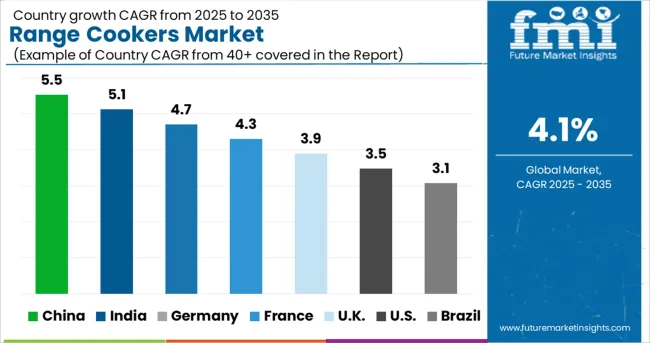
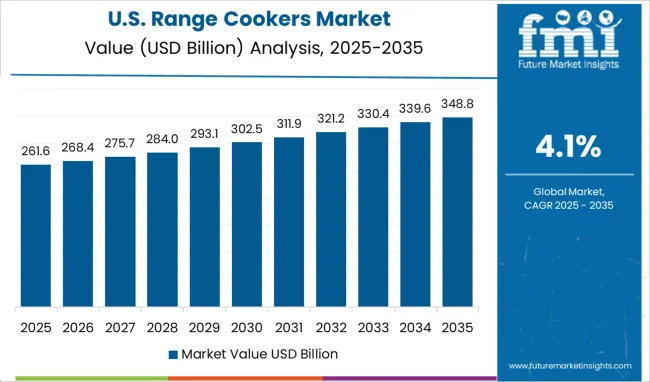
Rising Trend of Home Cooking to Boosting the USA Market
The USA has emerged as a promising market for range cookers and it is expected to reach a market valuation of USD 3.4 million by 2035. The growing trend of home cooking, the availability of advanced products, and the rising popularity of affordable mobile kitchen rentals are some of the key factors driving the USA range cookers industry.
Similarly, due to the subsequent modification trend of domestic dwellings, sales of related products are also rising in the United States. A rise in home improvement or remodeling spending is also being reflected in increased demand for home improvement or remodeling products.
The growing popularity of food-at-home cooking and the influence of social media, publications, and TV shows on cooking ideas and recipes, are increasing public knowledge of various cooking techniques. As a result, demand for range cookers is expected to surge over the projection period.
Rising Export of Kitchen Equipment Generating High Demand for Range Cookers in China
As per FMI China will continue to remain one of the lucrative markets for range cookers owing to the rising export of kitchen equipment, the strong presence of leading range cooker manufacturers, and the growing adoption of range cookers in the residential sector. FMI has predicted the China market to reach a total valuation of USD 443.0 million, by the end of 2035.
Revaluation of urbanization, vigorous promotion of merchandise by companies, and rising disposable income of customers are also major factors contributing to increased sales of range cookers in the country.
Surging Population and Rapid Urbanization Fuelling Sales in India
According to Future Market Insights, the overall market for range cookers in India is expected to reach a valuation of USD 254.9 million during the forecast period, making it one of the most lucrative markets across South Asia.
Rising sales of cooking appliances like range cookers are due to rapid urbanization, easy availability of products through online shopping platforms, and a rise in the proportion of people who cook at home due to the increasing purchasing power.
Attractive Benefits of Dual Fuel Range Cookers Making Them Extremely Popular
Based on product type, the dual-fuel range cooker segment is expected to reach a market valuation of USD 346.4 million during the forecast period owing to a rising end-user preference for dual-fuel range cookers due to their various advantages.
Dual fuel range cookers provide higher temperature and heat control than electric ones. They have become convenient heating and cooking solutions for consumers as they save space in the kitchen and give the kitchen a modular and new look.
Dual fuel range cookers feature both a gas cooktop (or hob) and electric ovens. By combining both fuel types into an all-in-one freestanding appliance, dual fuel range cookers allow users to take advantage of both fuel sources for optimal cooking, improving the meals that their kitchen produces.
Growing Popularity of Modular Kitchens Encouraging Adoption in the Residential Sector
As per FMI, the overall sales of range cookers in the residential/household category are expected to reach a market valuation of USD 643.5 million during the targeted period. The reason for the adoption of range cookers in residential/households is that consumer perception is changing toward modular kitchens.
Similarly, as more and more customers are getting influenced by western culture, they are looking to make their kitchen look smart by installing novel kitchen equipment like range cookers. This will further boost sales in the residential sector.
Product innovation and Research and Development (R&D) are top priorities for major industry players as they work to provide products with a variety of oven and hob combinations. In addition, leading manufacturers are expanding their presence and strengthening their distribution network through acquisitions, mergers, alliances, and partnerships.
For instance:
| Attribute | Details |
|---|---|
| Estimated Market Size (2025) | USD 2.3 billion |
| Projected Market Size (2035) | USD 3.4 billion |
| Anticipated Growth Rate (2025 to 2035) | 4.1% CAGR |
| Forecast Period | 2025 to 2035 |
| Historical Data Available for | 2020 to 2024 |
| Market Analysis | billion for Value |
| Key Regions Covered | North America; Latin America; Europe; South Asia; East Asia; Oceania; and the Middle East & Africa |
| Key Countries Covered | USA, Canada, Germany, United Kingdom, France, Italy, Spain, Russia, China, Japan, South Korea, India, Thailand, Malaysia, Indonesia, Australia, New Zealand, GCC Countries, Turkey, Northern Africa, and South Africa |
| Key Segments Covered | Product Type, Application, Burner Type, Sales Channel, Region |
| Key Companies Profiled | GE Appliances; SAMSUNG; Premier; Monogram; LG Electronics; Frigidaire; THERMADOR; Dacor, Inc.; Whirlpool Electric; LG Electronics; Panasonic; Miele & Cie KG; Hisense, INC.; Gree Electric Appliances Inc.; Sony Corporation; Skyworth; Others (on request) |
| Report Coverage | Market Forecast, Company Share Analysis, Competition Intelligence, DROT Analysis, Market Dynamics and Challenges, and Strategic Growth Initiatives |
The global range cookers market is estimated to be valued at USD 2.3 billion in 2025.
It is projected to reach USD 3.4 billion by 2035.
The market is expected to grow at a 4.1% CAGR between 2025 and 2035.
The key product types are dual fuel range cooker and electric range cooker.
residential segment is expected to dominate with a 68.4% industry share in 2025.






Full Research Suite comprises of:
Market outlook & trends analysis
Interviews & case studies
Strategic recommendations
Vendor profiles & capabilities analysis
5-year forecasts
8 regions and 60+ country-level data splits
Market segment data splits
12 months of continuous data updates
DELIVERED AS:
PDF EXCEL ONLINE
Orange Compound Market Size and Share Forecast Outlook 2025 to 2035
Orange Terpenes Market Size and Share Forecast Outlook 2025 to 2035
Market Share Insights for Orange Extract Suppliers
Competitive Overview of Orange Juice Market Share
Gas Ranges Market
Long-range Camera Market Forecast and Outlook 2025 to 2035
Acid Orange Market
High Dynamic Range Market Size and Share Forecast Outlook 2025 to 2035
Visible Light Range Scientific Camera Market Size and Share Forecast Outlook 2025 to 2035
Electric Bike Range Extender Market Size and Share Forecast Outlook 2025 to 2035
Unconcentrated Orange Juice Market Analysis - Size, Share, & Forecast Outlook 2025 to 2035
Electric Vehicle Range Extender Market Size and Share Forecast Outlook 2025 to 2035
Commercial Countertop Ranges Market Size and Share Forecast Outlook 2025 to 2035
Commercial Restaurant Rangers Market
Commercial Gas Restaurant Ranges Market Size and Share Forecast Outlook 2025 to 2035
Portable Buffet and Drop-In Ranges Market Size and Share Forecast Outlook 2025 to 2035
Commercial Electric Restaurant Ranges Market Size and Share Forecast Outlook 2025 to 2035
Pressure Cookers Market
Commercial Cookers Market Size and Share Forecast Outlook 2025 to 2035

Thank you!
You will receive an email from our Business Development Manager. Please be sure to check your SPAM/JUNK folder too.
Chat With
MaRIA